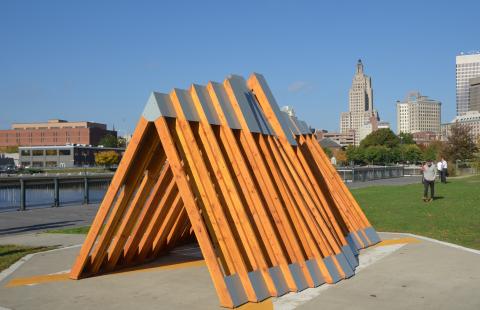What were the specific goals of this creative economy project? Describe the community development challenge or opportunity that your project was designed to address:
The I-195 Redevelopment District Commission was created in late 2011 to serve as the responsible authority for the sale, marketing and oversight of The LINK, twenty acres of land freed up by the relocation of Interstate 195. The LINK is in a great location and has fully-equipped infrastructure. The Commission has competitively positioned The LINK for redevelopment because of a tactical branding and marketing strategy for increasing interest in the District and the established transparent, expedited path to development. However, since the completion of The LINK could take decades, part of the Commission's task has been to figure out a temporary use for the land in line with the overall goal for the space: something that enriches the surrounding urban environment, generates excitement for The LINK, and promotes economic development. The Creative Mile accomplishes all these goals and also acts as a very visible space for local artists to showcase their creative talents.
If the goals change over time, please describe how:
The Commission continues to be committed to its original goals for The Creative Mile, which are to enliven the urban landscape with temporary artistic interventions and thereby generate enthusiasm for the future development of The LINK and the economic development of the land—and Providence as a whole—that will follow. However, as the first 6 pieces were installed in May 2014, the Commission saw an opportunity to succeed in helping transform Providence into a more walkable and bikeable city. Wayfinding signage and a map of the installations were distributed to key businesses and cultural points-of-interest in the city in an effort to encourage residents—on foot or by bike—to see The Creative Mile and explore Providence.
Who was involved in this project and what did they do? (be sure to include the partners from outside of the creative sector and how local voices were included):
The Commission staff has been the central organizer and executor of The Creative Mile. However, in the early stages of the program, a group of interested creative parties and stakeholders from the city helped shape the overall goals and vision of The Creative Mile. In addition to Commission staff, this group was comprised of Commission board members and staff from The Steel Yard (a community arts and technical training school), the city’s Department of Arts, Culture, and Tourism, Jewelry District Neighborhood Association, and the Children’s Museum. Once a Call for Submissions was issued, this group also acted as a jury to review and select proposals for installation on The LINK. Additional funding came from local nonprofits Providence Foundation and Rhode Island Foundation. Actual installation was done with guidance from the Rhode Island Department of Environmental Management, resources from the Rhode Island Department of Transportation and the technical skill and expertise of engineering firm Fuss & O’Neill. Finally, a partnership was formed with The Avenue Concept, a local nonprofit targeted at producing public arts programming for the city. The Avenue Concept provided funding for The Creative Mile as well as marketing and promotional resources in pursuit of greater goals for Providence, like the activation of public space and increased civic engagement with the arts.
How does this project relate to a larger community development strategy?
The Creative Mile plays into some of the goals outlined in the Commission Developers’ Toolkit, which describes methods through which private developers, public agencies, and other investors can collaborate to build a unique district where people from all backgrounds can work, live and enjoy Providence. One of these goals is specifically interim parcel programing, which promotes walkability, public amenity, and economic development, especially in areas of The LINK where development will not begin for one to three years. With the implementation of The Creative Mile, the Commission has set a standard for future collaborators in The LINK that demonstrates the importance of interim use programming in redevelopment of the land.
The Creative Mile also achieves the more sweeping, citywide goals. One is to create a more walkable and bikeable city, and another is to establish creative temporary use programs as a standard in Providence. The arts and design culture in the city is an important component of what makes the city such a great place to live and work, and The Creative Mile is a piece of a greater movement to organize a comprehensive approach to creative interim use and artistic neighborhood intervention programs in the city, which in turn can inspire residents discover and connect to Providence.
What projects or places, if any, inspired your approach to this creative economy project?
The Creative Mile is modeled off of the Convergence International Arts Festival that ran for sixteen years in Providence until 2003. Considered one of the premiere arts festivals in the country, Convergence was a three-week statewide festival centered in downtown Providence with sites spread throughout Rhode Island. It featured large-scale public sculpture by nationally and internationally recognized artists. While The Creative Mile is smaller and scale and exclusively features local talent, the vision of a free outdoor art exhibition accessible to the public 365 days a year has been the foundation of The Creative Mile as much as it was the foundation of Convergence.
